There are several contributing factors to this kind of high in the rear posture, and conditioning can definitely help!!
The technical term for “high in the rear” posture is lordosis / kyphosis. Lordosis refers to the concave portion of the curve. This is highlighted in red below. Kyphosis refers to the convex portion, highlighted in yellow.
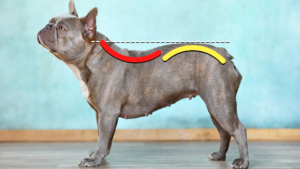
Sometimes this is the result of intentional breeding. Some breeds are intentionally bred to have this shape top line, including several molosser breeds (bull type breeds). This is often correlated with a straighter rear end angulation or a length imbalance between the femur and tibia / fibula.
Sometimes this is the result of early spay / neuter. When neutering before growth plates are closed, the long bones continue to grow as the hormonal “stop growing” signal is absent.
Sometimes this is the result of funny genetics in mixed breed dogs. When we combine unknown genetics sometimes this type of thing results.
Is a dog who’s high in the rear at an increased risk of injury? And what can we do about it?
The underlying structure can increase risk of injury to the shoulder, thoracic spine, and potentially the stifle depending on stifle angulation. So we definitely want to implement a structured conditioning program to help improve muscle balance and reduce injury risk. Let’s go over the three major areas that are affected by high in the rear posture.
A. Shoulder:
Because the rear end is so high, extra load is shifted into the forehand. On average, dogs typically carry 60% of their weight in the forehand. With a dog high in the rear, even MORE weight is shifted into the forehand. This leaves the shoulder, specifically the bicep and supraspinatus at increased risk. Developing really strong musculature around the shoulder as well as the skill of loading into the rear end can help mitigate injury risk.
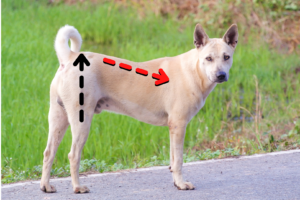
Exercises like Head Nods, Backing Up, and Shoulder Strength & Stability Series can help build strength in the shoulder.
B. Thoracic spine:
During deceleration, and other impact activities, the spine should compress like a spring, and distribute the load evenly through the spinal column. But because of the curved spine alignment typical in dogs who are high in the rear, the spine is much more likely to compress at one vertebral level versus distributing load evenly throughout. As a result any deceleration forces are likely to overly compress the disc at the most convex aspect of the curve (thoracic lordosis). We know that bone grows to stress (Wolff’s law). So repeated impact / compression at a singular level can result in bony growth (bone spurs) at that level. These bone spurs can be very uncomfortable, and even result in nerve impingement.

Working to maintain a strong core to minimize the thoracic lordosis will be important as well. Exercises like Standing Side Bend and Bow can help mobilize the thoracic spine, reducing tension and trigger points. Exercises like Fold Back Down, Plank, and Dig Dig can strengthen the core to help prevent the lordosis from progressing, and even lessen the severity of the curve.
C. Stifle:
Many dogs who are high in the rear, also have straight stifle angulation. This is due to the relationship between a high rear and the underlying stifle angulation. Think of how a scissor lift moves from having the struts be more horizontal and angulated to more vertical and straight as the height increases. The relationship between the pelvis and stifle angulation works in a similar way.

Studies have shown dogs who are excessively straight in the rear are at an increased risk for CCL rupture and potentially at an increased risk for meniscal damage. This is because the joint is not able to work as a shock absorber in the same way as a dog with more typical stifle angulation. As a result, forces are translated into the meniscal cartilage.
Exercises like Power Up, Ipsilateral Foot Target, Adducted Stand and Cavaletti can help keep the musculature around the stifle strong. Having strong musculature reduces the impact on the underlying structures.
Want to see a real life example of a dog who improved their high in the rear posture?
Check out Winchester, a Belgian Malinos. At about 2 years old, his handler Emily recognized this posture wasn’t reconciling as Winchester reached skeletal maturity. High in the rear posture is commonly “brushed off” as a growing phase. So Emily took measures to implement a formal conditioning program. 6 months later and Winchester is showing much less thoracic lordosis, increased muscle mass and is even starting to play some sports as a hobby!! I am so proud of their progress!!!
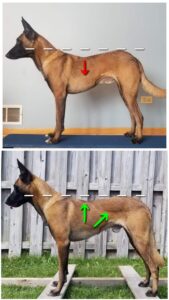
So if you have a dog that is high in the rear, check out the exercises mentioned above. We definitely want to work to mitigate the risk to the shoulder, thoracic spine and stifle mentioned above through targeted conditioning exercises. If you’re looking for something with more guidance, including which exercises to do together, how many repetitions to start with, how many to work toward, and what exercises to do next, check out the Strong Dog Program (for dogs not competing in sports) or the Sport Dog Program. I have written the Zone Focus Track specifically for you!!
All of that to say… A lot can be done to help your pup have a long healthy life. It doesn’t have to be fancy and it doesn’t have to be expensive. This is something to be concerned about and action should be taken. It’s not going to be “corrected” because high in the rear is an underlying structural issue. BUT we can certainly implement some measures to help improve alignment, build strength in the weak / at risk areas, and mobilize those areas that are tight.
Happy Conditioning!!!! And if you ever have questions, drop a comment in the comments section below, and I will get back to you ASAP!


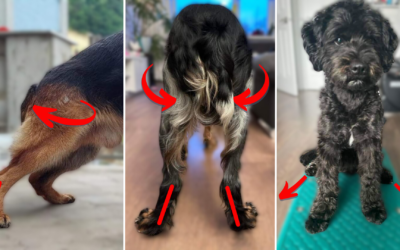
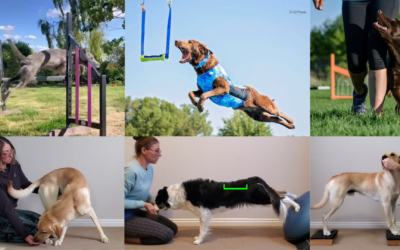
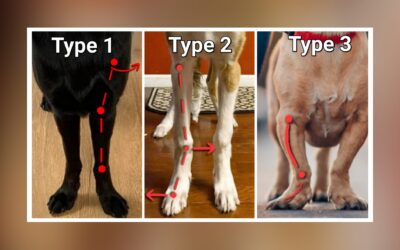
This transformation is absolutely amazing! I never would have thought it possible. As a former horse trainer, I ran across a lot of horses purposely bred low in front as western pleasure horses. This resulted in extreme weight load carrying in the front and a short strided trot and lope. When people tried using these horses for dressage and getting more collection and weight shift to the back, the horse was structurally incapable of doing it. These horses tended to break down early. So, I was skeptical that exercises for posture could help a dog that much. Wonderful to see! Thank you for posting this.
Hey Becky!
The change is pretty amazing!! And even in cases where this type of change doesn’t happen, there are still tons of benefits that can result from implementing a targeted conditioning program.
The loading into the forehand this type of high in the rear posture creates (like you mentioned) is my biggest concern. Keeping the shoulder strong is really important.
But the change Emily and Winchester were able to achieve sure is something!!
My french bulldog has the exact side profile as the frenchie in your article. He has a high rear. Like a little hump. Are frenchies breed to be this way or can he benifit from your conditioning program?
Hey Elizabeth!
I’m not 100% up on the current breed standard for French Bulldogs. But even if this spine alignment is intended / intentionally bred, we still want to take steps to support the elbow and shoulder (since they are responsible for even more load than is typical with a level topline), as well as promoting functional core strength to ensure the lordosis / kyphosis doesn’t continue to increase over time. I do offer several free suggestions regarding exercises that an help. Alternatively, if you’re looking for something more formal, implementing the Beginner Program would be a good place to start teaching the foundational skills needed.
Hi, should I worry if my 7-month-old mixed-breed male puppy has this slope, considering he hasn’t finished growing ? He was neutered by the rescue at 4 months old. He’s mainly a sherpherding mix with some labrador.
Hey Lyly!
That’s a great question! I’m so glad you reached out! High in the rear posture is very common with early spay / neuter, due to how the lack of hormones impact the growth rate of the long bones. BUT there are still measures we can take to support the elbow and shoulder (since they are responsible for even more load than is typical with a level topline), as well as promoting functional core strength to ensure the lordosis / kyphosis doesn’t continue to increase over time. I do offer several free suggestions regarding exercises that an help. Alternatively, if you’re looking for something more formal, implementing the Beginner Program would be a good place to start teaching the foundational skills needed.
After completing the Beginner Program, you could transition to the Strong Dog Program if you’re not pursuing a high impact lifestyle, or the Sport Dog Program if you are thinking of participating in high impact sports.
Thank you for this article!! I am a farrier/horse trainer currently learning about thoracic sling improvement in horses and it does indeed reverse so many postural ailments much like “downhill conformation”! My dog just experienced a CCL rupture and is “high in the rear” as well. I didn’t understand it before, but now the correlation is just amazing! I will definitely be working to help him condition his body to prevent future damage. I’m just thrilled at seeing this information translate across species. Thank you again for this article and exercises!!
Hey Emily!
I’m so glad you found this information useful! And YES!!! So much information translates across species. Dogs, like horses, are master compensators, so understanding how posture and compensation are related can be used to inform a fitness protocol to help address those compensations.
Lastly, I’m so sorry to hear your pup ruptured his CCL. My BC ruptured both and has 2 TPLO’s, so I can certainly empathize. If you have any questions to that end, please don’t hesitate to shoot me an email [email protected]
I have a male maltipoo puppy that I acquired at 6 months old. He is now coming up on his 7th month in 10 days. I am waiting a few more months before neutering to allow for proper maturity.
He was on Caesar brand dog food for the 8 weeks he was with the last person who had him. I do not know his blood line and so do not know what the conformation of the pup’s damn and sire.
I changed his food to a more appropriate diet. Puppy adolescence has begun and in the last 3 weeks I noticed a high rear conformation with a slight upward curvature in the transverse area of the top line.
Would this be considered a part of genetic development or an injury?
Is it possible for this to correct itself as the puppy finishes developing? Or will this remain given he is a small breed and coming up on his 7th month?
Should I consider the exercises or program mentioned in the article now ?
Hey Cindy!
These are great questions. It’s possible that the high in the rear posture is the result of a growth phase… But in such a small dog, the vast majority of growth plates are closed by this time… So while possible, it’s less likely than if this was a large dog.
Best practice in this situation would be to start with a consult with a Sports Medicine Vet or Rehab Professional to get a baseline, And then depending on the results of their assessment, you may need to implement some custom rehab exercises they provide, or if you are cleared, you could certainly start on some formal conditioning exercises.
Given your pup’s age, I would start with the exercises in the Puppy Program. The Puppy Program includes all the most important skills the more targeted exercises mentioned in this article build upon.